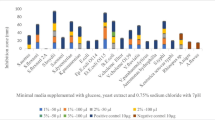Abstract
We investigated the diversity of epibiotic bacteria possessing antimicrobial activity isolated from nine species of red algae, and identified their phylogenetic position. For the isolation of epibiotic bacteria, nine species of red algae, Pachymeniopsis lauceolata, Plocamium telfairiae, Gelidium amansii, Chondrus oncellatus, Grateloupia filicina, Ceramium kondoi, Lomentaria catenata, Schizymenia dubyi and Porphyra yezoensis, were collected from the intertidal zone of Awaji Island, Japan. In total 92 bacteria were collected from the above red algal species. Primary screening results using disc diffusion assay revealed that 33% of bacteria possess antibacterial activity. Ten bacteria that showed high antibacterial activity were further studied for their ability to inhibit a set of fouling bacteria, some luminescent Vibrio and Photobacterium species and a panel of pathogenic bacteria. In general, the inhibitory activities were high against fouling and luminescent bacteria, while low against various pathogenic bacteria tested. These results suggest that some epibiotic bacteria have adapted to defend their position in their surface environment through the production of antibacterial metabolites giving defense against a broad spectrum of bacterial competitors. The phylogenetic analysis using 16 S rRNA sequences identified 7 of the 10 strains as belonging to the genus Bacillus, and other strains each 1 belonging to genus Microbacterium, Psychrobacter, and Vibrio species.

Similar content being viewed by others
References
Barsby T, Kelly MT, Gagne SM, Andersen RJ (2001) Bugorol A produced in culture by a marine Bacillus sp. reveals a novel template for cationic peptide antibiotics. Org Lett 3:437–440
Bauer AW, Kirby WMM, Sherries JC, Truck M (1966) Antibiotic susceptibility testing by a standard single disc method. Am J Clin Pathol 45:493–496
Boyd KG, Adams DR, Burgess JG (1999) Antibacterial and repellent activities of marine bacteria associated with algal surfaces. Biofouling 14:227–236
Burgess JG, Mearns-Spragg A, Jordan EM, Bregu M, Boyd KG (1999) Microbial antagonism: a neglected avenue of natural products research. J Biotechnol 70:27–32
Burgess JG, Boyd KG, Armstrong E, Jiang Z, Yan L, Berggren M, May U, Pisacane T, Granmo A, Adams DR (2003) The development of a marine natural product-based antifouling paint. Biofouling 19:197–205
Chelossi E, Milanese M, Milano A, Pronzato R, Riccardi G (2004) Characterisation and antimicrobial activity of epibiotic bacteria from Petrosia ficiformis (Porifera, Demospongiae). J Exp Mar Biol Ecol 309:21–33
Dixon J, Schroeter SC, Kastendiek J (1981) Effects of the encrusting bryozoan, Membranipora membranacea, on the loss of blades and fronds by the giant kelp Macrocystis pyrifera (Laminariales). J Phycol 17:341–345
Dobretsov S, Qian PY (2002) Effect of bacteria associated with the green alga Ulva reticulata on marine micro- and macrofouling. Biofouling 18:217–228
Egan S, Thomas T, Holmstrom C, Kjelleberg S (2000) Phylogenetic relationship and antifouling activity of bacterial epiphyes from the marine alga Ulva lactuca. Environ Microbiol 2:343–347
Egan S, James S, Holmstrom C, Kjelleberg S (2001) Inhibition of algal spore germination by the marine bacterium Pseudoalteromonas tunicata. FEMS Microbiol Ecol 35:67–73
Felsenstein J (1985) Confidence limits on phylogenies: an approach using bootstrap. Evolution 39:783–791
Hentschel U, Schmid M, Wagner M, Fieseler L, Gernert C, Hacker J (2001) Isolation and phylogenetic analysis of bacteria with antimicrobial activities from the Mediterranean sponges Aplysina aerophoba and Aplysina cavernicola. FEMS Microbiol Ecol 35:305–312
Holmstrom C, Kjelleberg S (1999) Marine Pseudoalteromonas species are associated with higher organisms and produce biologically active extracellular agents. FEMS Microbiol Ecol 30:285–293
Holmstrom C, James S, Egan S, Kjelleberg S (1996) Inhibition of common fouling organisms by pigmented marine bacterial isolates. Biofouling 10:251–259
Jaruchoktaweechai C, Suwanborirux K, Tanasupawatt S, Kittakoop P, Menasveta P (2000) New macrolactins from a marine Bacillus sp. Sc026. J Nat Prod 63:984–986
Kanagasabhapathy M, Sasaki H, Haldar S, Yamasaki S, Nagata S (2006) Antimicrobial activities of marine epibiotic bacteria isolated from brown algae of Japan. Ann Microbiol 56:167–173
Lemos ML, Toranzo AE, Barja LJ (1986) Antibiotic activity of epiphytic bacteria isolated from intertidal seaweeds. Microb Ecol 11:149–163
Nagata S (1988) Influence of salts and pH on the growth as well as NADH oxidase of the halotolerant bacterium A505. Arch Microbiol 150:302–308
Oclarit JM, Okada H, Ohta S, Kaminura K, Yamaoka Y, Iizuka T, Miyashiro S, Ikegami S (1994) Anti-Bacillus substance in the marine sponge, Hyatella species, produced by an associated Vibrio species bacterium. Microbios 78:7–16
Swofford DL (1999) PAUP*: Phylogenetic analysis using parsimony (*and other methods), Version 4.03ba. Sinauer Associates, Sunderland, Massachusetts
Thakur NL, Anil AC (2000) Antibacterial activity of the sponge Ircinia ramosa: importance of its surface-associated bacteria. J Chem Ecol 26:57–72
Thompson JD, Higgins DG., Gibson TJ (1994) CLUSTAL W- improving the sensitivity of progressive multiple sequence alignment through sequence weighting, position specific gap penalties and weight matrix choice. Nucleic Acids Res 22:4673–4680
Wahl M (1997) Living attached: aufwuchs, fouling, epibiosis. In: Nagabhushanam R, Thompson M (eds) Fouling organisms of the Indian Ocean: biology and control technology. Oxford and IBH Publ, New Delhi, pp 31–34
Wicke C, Huners M, Wray V, Nimtz M, Bilitewski U, Lang S (2000) Production and structure elucidation of glycoglycerolipids from a marine sponge-associated Microbacterium species. J Nat Prod 63:621–626
Zheng L, Han X, Chen H, Lin W, Yan X (2005) Marine bacteria associated with marine macroorganisms: the potential antimicrobial resources. Ann Microbiol 55:35–40
Author information
Authors and Affiliations
Corresponding author
Rights and permissions
About this article
Cite this article
Kanagasabhapathy, M., Sasaki, H. & Nagata, S. Phylogenetic identification of epibiotic bacteria possessing antimicrobial activities isolated from red algal species of Japan. World J Microbiol Biotechnol 24, 2315–2321 (2008). https://doi.org/10.1007/s11274-008-9746-y
Received:
Accepted:
Published:
Issue Date:
DOI: https://doi.org/10.1007/s11274-008-9746-y




